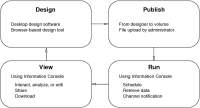Understanding content life cycle
All content is stored in an Encyclopedia volume through one of the following methods:

Run or schedule a file job.

Save a document from a browser-based tool.

Publish a document from an Actuate desktop designer software.

Upload a file by an Actuate Encyclopedia volume administrator.
Information Console users either view an existing document for printing and editing, or run a job to create a document with updated or filtered data.
Users with appropriate privileges can open design and template files in browser‑based tools to change the design or data sources. Files opened in browser-based tools for design can be republished to the Encyclopedia volume.
Figure 1‑2 shows the typical content life cycle that Information Console supports.
Figure 1‑2 Content life cycle
